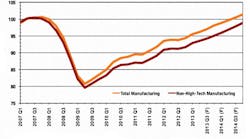Ten years ago, a list of myths about manufacturing would have started with the humdinger that we no longer make anything in America. But behind the efforts of MAPI, the National Association of Manufacturers, the White House and others, many more Americans are familiar with the continued dynamism of this nation's factory sector. Still, myths abound. Some diminish manufacturing's value; others create unrealistic expectations for the sector. It's important to correct all of them in order to ensure more focused and effective public policies.
See Also: Global Manufacturing Economy Trends & Analysis
Here are three myths that continue to arise in the media:
1. We don't need to actually make anything here to create wealth. A persistent myth is the concept that it doesn't matter where production occurs because America can remain competitive by selling its ideas. Unfortunately, we now have three decades of evidence to rebut this argument.
Some ideas are more valuable than others -- that is, they generate more wealth for society. Such is the case with manufacturing innovation. Manufacturers spend more dollars on R&D than other sectors, and because of the multiplier effect, such activity tends to have a greater impact. When production goes overseas, we lose this innovation because in many cases designers and engineers trail the factories to their new locations in order to more quickly and effectively facilitate process and product changes.
The damage doesn't stop there. Once production is established in a specific locale, a community of designers, suppliers, researchers, investors, and skilled workers develop around it -- what Harvard's Gary Pisano and Willy Shih call an "industrial commons." This facilitates the next generation of innovation in that region. Thus, when the United States outsourced the production of TVs to Asia several decades back, that region gained (and we lost out on) the innovation and production of plasma, LED and liquid crystal displays (LCD) TVs -- and who knows what next. We can't afford to continue hemorrhaging our advanced manufacturing capabilities.
2. We're in the midst of a manufacturing renaissance.
While a U.S. manufacturing renaissance is possible, we're not there yet. In fact, U.S. manufacturing hasn't even fully recovered from the Great Recession and isn't expected to until the 4th quarter of 2014. Manufacturing output today is only 75% of what it was at its prerecession peak, and with only 500,000 jobs added since the trough, the sector may never recover the almost 2.3 million jobs lost between December 2007 and June 2009.
That said, some crucial factors are helping make the United States a more attractive production platform for companies, most notably the shale gas revolution and the narrowing of China's labor cost advantage. According to a MAPI-Aspen Institute report, just a handful of policy changes -- in tax, energy, regulation and trade -- could lead to a true U.S. manufacturing revival, creating 3.7 million additional jobs by 2025, a 12% increase in capital investments, a 5 % increase in GDP and a shift from a national trade deficit to a surplus.
In other words, a renaissance is possible but not without help from policymakers.
3. "American made" means made by a U.S.-based company. The transition to a global marketplace has altered the way we must define "American made." The auto industry is a case in point: For years, an American car was perceived as one made by Ford, GM, or Chrysler (which has, in fact, been foreign-owned since 1998). But more than half of the so-called foreign cars sold in the U.S. today are actually made here. In all, nearly 100,000 Americans work at foreign-owned auto plants in this country.
Autos may be the most glaring example of foreign-owned manufacturers making stuff in this country, but many other examples abound: EADS makes jets here, Novartis and GlaxoSmithKline make prescription drugs and vaccines, Bridgestone and Michelin make tires, and Siemens makes a laundry list of goods, including power distribution and smart grid equipment.
In all, U.S. subsidiaries of global companies employ close to 6 million workers here -- almost 40% of whom are in manufacturing. Foreign-owned manufacturers are responsible for almost one-fifth of all exports from this country. If it's produced here, the impact on the U.S. economy is the same no matter what the language of the parent company.
Stephen Gold is president and CEO of Manufacturers Alliance for Productivity and Innovation, Arlington, Va. (www.mapi.net).






